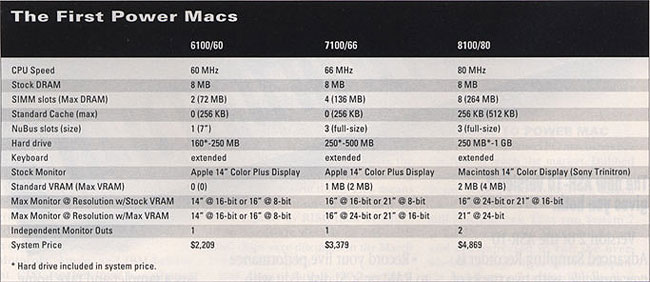 p2 p2 |
|
|
By late 1995 or early 1996, Apple expects to ship Power Macs that use the PowerPC 604 chip. This supposedly will be the leader of the 32-bit pack, but not much else has been revealed. The final PowerPC chip announced for Apple computers (so far) is the 620, a completely 64-bit design due sometime in 1996. All we have been told is that the 620 will offer super-fast multiprocessing for big-time workstations and supercomputers. By the way, Motorola also is developing market-specific PowerPC chips for consumer electronics, computer peripherals, and assorted control and communications applications. One minor drag is that System 7 still uses cooperative multitasking instead of the preemptive multitasking offered in the Commodore Amiga. This means that although applications can run in the background, there will still be times when one operation takes over your Mac, and you have to wait to switch programs. Apple apparently is considering changing to preemptive multitasking someday-it's an operating system issue, not a hardware limitation-but it is a low priority at the moment. Besides, it could open a can of worms for developers. Dancing Madly Backward A certain amount of compatibility problems are inevitable when a major hardware or operating system changes: many Macintosh users had problems switching to System 7, the 68040 CPUs, and the PowerBooks. PC folks had to go through hard times with Windows, despite Intel's and Microsoft's attention to compatibility issues. And don't even ask an Atari ST user about the problems encountered when upgrading to the Mega. Apple warns us to expect problems with as much as ten percent of existing programs, which is pretty good. Apple's confidence in the Power Mac's backward compatibility is rooted in the fact that the new computers have the 68LC040 instruction set stored in ROM. To a pre-Power Mac program, a Power Mac looks a 68040. A Mix Mode Manager lets 680x0 code and PowerPC code run at the same time. Also, the Power Macs operate under System 7.1.2, which is call-for-call compatible with System 7.1. In theory, anything that is 68040-compatible and System 7.1-compatible should run fine.
|
Apple will start out with three mid- to upper-market Power Macintoshes. The Power Macintosh 6100/60 (CPU only, $1,819) is the entry-level computer, offering a pizza-box design with one 7-inch NuBus slot. The Power Macintosh 7100/66 (CPU only, $2,899) runs about 25% faster than the 6100/60 and could prove extremely popular among electronic musicians on a moderate budget. The first-generation top-of-the-line is the Power Macintosh 8100/80 (CPU only, $4,249). This tower of power is nearly twice as fast as the 6100/60. All models are available as complete systems (see "The First Power Macs," below), with color monitor; extended keyboard; 1.44 MB floppy drive; internal hard drive; SCSI; Ethernet; two LocalTalk and GeoPort-compatible serial ports; Apple Desktop Bus input; 1/8-inch, stereo, line-level audio input; 1/8-inch, stereo, line-level, audio output; and 8 MB of RAM soldered to the motherboard. Additional RAM slots accept 70 ns, 72-pin SIMMs, added in pairs. A CD-ROM drive is also available. Although the 256 KB Level 2 cache is optional ($299) on the 6100/60 and 7100/66, it is highly recommended, as it considerably speeds up many operations by providing the PowerPC 601 chip with immediate access to fast memory for storing most-used commands. The 8100/80's standard 256 KB cache can be expanded to 512 KB. In addition, all three models are available in AV versions. However, unlike the Centris/Quadra 660AV and 84OAV, the AV Power Macs do not include a DSP chip; the designation refers to video I/O. The AV Power Macs offer NTSC and PAL video I/O and SECAM video in. An S-video I/O interface is provided, with composite (RCA) adapters. Video-in capabilities include a resizable window and frame and video capture. If you buy a non-AV Power Mac and later want to add video I/O, an AV NuBus card is available for $200 to $300. ’ÄîSO |
 |
|
return to top |
|